I just bought a pair of ROBO kickers but every time I step my shoe rubs against the toe part of the kicker and makes a really annoying squeaky noise. Are there any suggestions to get rid of the squeek?
Thanks
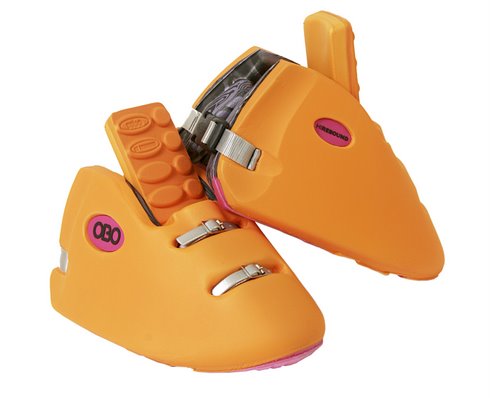
Keepers Resources
With so many manufacturers, brands and product offerings – what’s the difference?
I just bought a pair of ROBO kickers but every time I step my shoe rubs against the toe part of the kicker and makes a really annoying squeaky noise. Are there any suggestions to get rid of the squeek?
Thanks

Great article on the new FaceOff. Coming soon to OBO.
Hey Everyone!
Here’s something i thought might interest you. Its an article by the Manawatu Standard Newspaper on the top secret, brand new OBO FaceOff mask. Its an excellent article and shows just how committed OBO is, not just to hockey goalkeepers, but to defenders and other codes as well.
Want to fire a ball at Simon Barnett’s face at 160kmh? Bring it on, says the director of Palmerston North sports equipment company, OBO.It has taken three years, a four-strong team of designers and a sum of money that he would rather not think about, but Mr Barnett reckons he has the world’s best frontal-impact sporting mask.
Called Face-Off, the mask is designed for players of sports where the danger of being hit in the face by a high-speed ball is high, Mr Barnett said.
“It can instantly deflect a ball travelling at up to 160kmh , not only from damage caused by the ball – abrasions, bruises and cuts – but by attenuating the shock to the brain.”
OBO is a sports equipment m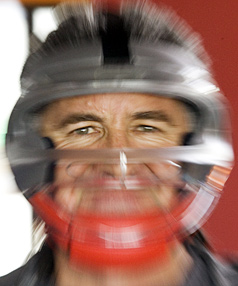 anufacturer, exporting protective gear for hockey goalkeeping to 62 countries.
anufacturer, exporting protective gear for hockey goalkeeping to 62 countries.
For Face-Off, Mr Barnett and his team built a laboratory to determine the best materials and design to deflect frontal impact.
They tested masks by firing balls at them at speeds of up to 160kmh, videotaping the impact at 2000 frames per second.
Footage taken during these trials, and destined for the OBO website, show masks exploding in showers of plastic, cracking and bending, or sliding haphazardly off the dummy’s face.
The testing on cricket face protectors in particular was “frightening,” Mr Barnett said. “They just don’t work.”
After the team had finalised their design, they handed the prototype mask to professional sports players for their opinion.
This was invaluable, Mr Barnett said. English wicketkeeper Matt Prior loved the mask, but said it was uncomfortable when sweating and made hearing difficult. So OBO inserted a layer of padding, and modified the side panels for the finished design, Mr Barnett said.
The mask’s launch is in its final stages, with buyers being sourced and marketing beginning in earnest.
A boost of $217,000 from the Foundation for Research, Science and Technology helped in the making of the mask but Mr Barnett “wouldn’t like to think about” how much money he had spent. He expected enough interest in the product to see a return within three years.
Face Off is one of nine inventions from around the country featuring in the HotHouse exhibition at Lower Hutt’s TheNewDowse gallery until February 14.
Keep an eye out for more information coming soon…
Check out this new look ROBO tattoo range!
Hey guys check out some pictures of the super sexy, brand new Tattoo range coming out soon from OBO.
Everyone we’ve shown them to has said they look pretty damn amazing.
The design is a New Zealand Maori symbol.
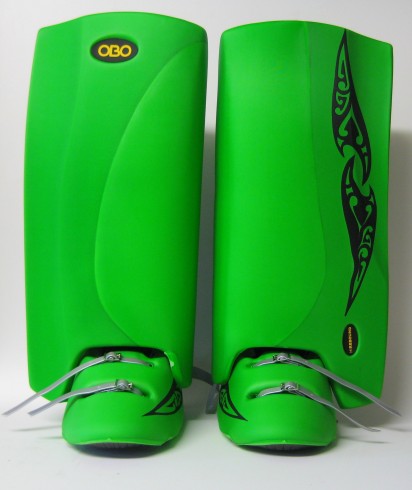
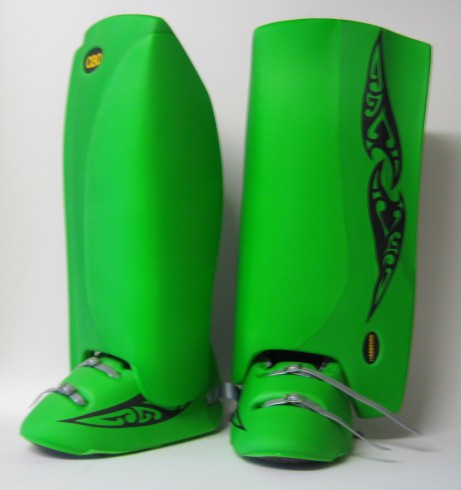
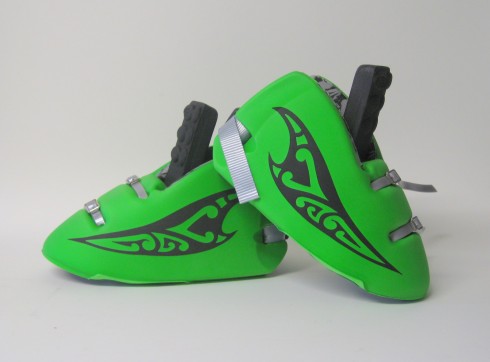
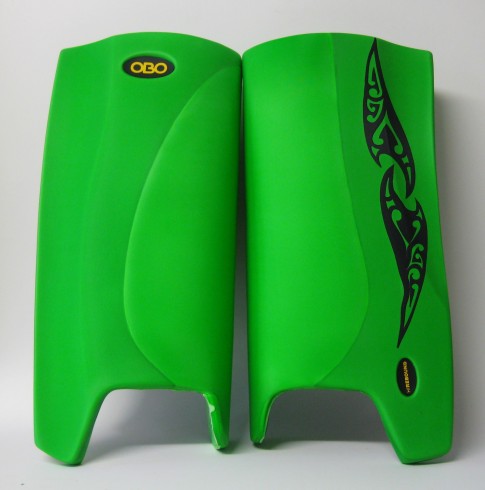
Leave some comments and tell us what you think!!!!!!
Our annual sale of factory seconds and discontinued lines is now underway! Full details can be found here…
http://www.obogoalkeeping.com/community/nov_sale_2009.php
Enjoy!
Our annual sale of factory seconds and discontinued lines is now underway! Full details can be found here…
Enjoy!
Here at OBO we want you to get as much use as you possibly can from your kit. We often get asked whats the best glue to use on foam…we used to advise contact adhesive, but we have just discovered a great glue made by Loctite for “hard to bond materials”. Its called Loctite Plastic Bonder and bonds to OBO foam like a bad boy! The consmer pack contains an activator and glue and bonds to OBO foam superbly. You should be able to get this product from your local hardware store..here is a link to product on the Loctite website. If you cant find this the Loctite code is 770 primer and 406 glue.
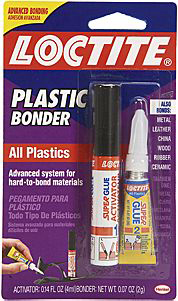
My review of the new OBO BOBBLA.
Hey guys. Here’s my final report on the last of the three products in Obo’s new training product range, the Bobbla. To be quite honest, when i first started using this unusual product i was not very impressed with it. I thought it a little simple and not as valuable and relevant as the Flicka or D’flecta. However after using it for a bit longer and talking with my coach about the use i discovered that skills used with the Bobbla were actually more relevant than either of the other two training products.
 Pictures of the Bobbla. The egg shape gives it its trademark bobble.
Pictures of the Bobbla. The egg shape gives it its trademark bobble.
When using the Bobbla, the idea is to look at and practice the basic kicking techniques which are essential to goalkeeping. The Bobbla is rolled at the goal and the keeper kicks it away from the goal. Just like in a simple warm up. However the Bobbla makes each part of that ‘simple’ warm up much harder. Instead of staying on the ground as an ordinary hockey ball would, the Bobbla bounces and spins as it rolls giving an unpredictable bobble as the keeper goes to kick. This means the keeper is forced to concentrate much harder on their timing and basic kicking technique. By using the Bobbla my coach was able to pick out that my left foot was not as skilled as my right foot at kicking, a common problem for a lot of keepers, i have since corrected this and both feet are fairly even.
Here is a beautiful picture of the Bobbla in action. The egg shape has made the ball bounce up as i am about to kick.
The unpredictability of the bobble also speeds up the reaction time of the keeper and keeps them focused on the ball. Because the final direction of the ball was always uncertain i found that the best strategy was to wait until the last minute to kick. This improved my reactions, foot-eye coordination and my timing. Because the ball was traveling slower and moving about i had to focus on the ball the whole time and this improved my concentration. A weakness of mine has always been the slower, bouncy shots and the training with the Bobbla was perfect for erasing that problem from my technique.
From my experience, i found that the Bobbla is most useful for correcting and reinforcing the basic goalkeeping kicking techniques. The flaws in my technique have been somewhat ironed out and the constant repetition has improved my kicking muscle memory and confidence. I believe that this product has a lot of potential for coaches and goalkeepers everywhere. I found it extremely beneficial to my game and was able to make much better use of my coaching sessions.
My review of the brand new OBO FLICKA.
As part of the Beta Testing Program i have been training with the Flicka extensively and have a range of feelings about it. I found it most useful for increasing my hand-eye coordination and my ability to track the ball through the air at different rates. The Flicka is designed to simulate aerial saves such as flicks and dragflicks. The ball is caught in the hook and flung so that the ball flies off towards the goal. Its a lot harder than it looks but when you get it it works great.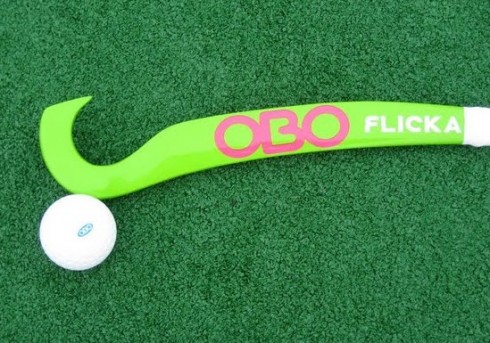
I found the Flicka a very good training product for increasing my confidence and ability when making glove and stick saves. Focusing on clearing the ball wide also improved my basic save technique and skill as a keeper. The Flicka was not as much use to me as it could be to others. I am already technically proficient and i was able to handle most of what the Flicka could throw at me. I found it more useful for creating muscle memory for getting to the ball, saving the ball and clearing the ball wide. I also found it very useful for increasing my skill with stick saves. By standing off to my left and trying to use only my right hand to save the flick i very quickly increased my stick save confidence.
I think this tool would be most useful for improving younger, less experienced goalkeepers who perhaps have slight flaws in their technique. The Flicka is better than a player flicking as quite often the player telegraphs which direction the flick is going. With the Flicka this is impossible to judge and so makes the save purely reactionary. The emphasis on making the save and clearing the ball also incorporates a degree of muscle memory which further enhances the keepers technique.
I also think the Flicka would be very useful for goalkeeper coaches. The coaches ability to control the speed and direction of the flick would greater allow them to control the training of the goalkeeper because sometimes field players cannot quite understand what the coach wants. This would allow the coach to individually tailor each flick to get the desired effect and get the desired reaction.
ROBO wheelie bag review by Leonie Hoffmann
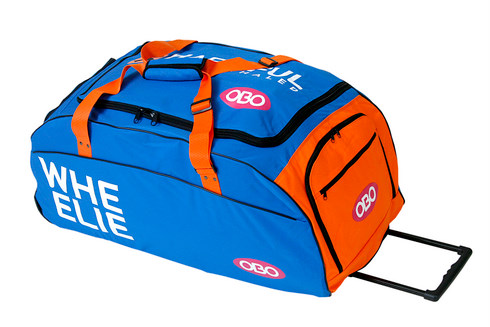
I think this bag is the best which was ever been created by OBO.I really love the colours.But in my opinion it should have more pockets to seperate things like hockeyshoes, the throat protector or the shirt, from the smelly stuff.
Kind regards from munich
Leonie Hoffmann
My review of the brand new OBO D’FLECTA.
Throughout this year i have been given the opportunity to train with and test the D’flecta, one of the new training products that Obo is bringing out on the first of December this year. I have used it in many different drills and using it has improved my reactions and confidence in making deflection shot saves.
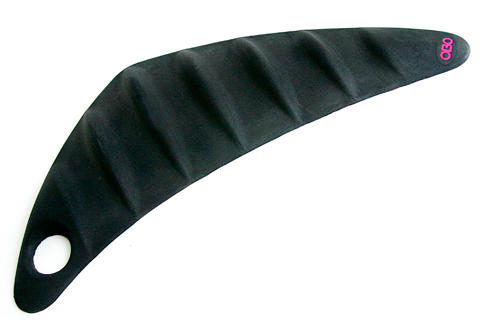
In basic use the D’flecta sits on around the penalty spot area. It can face either way (one side giving more height that the other) and a field player or coach hits or pushes a ball along the ground at it. When the ball hits the D’flecta it goes in any direction, sometimes it goes up, sometimes it goes wide and sometimes it stays on its original course. You cant judge this so its all about reactions. The trickiest part of the D’flecta i found was when the ball missed the D’flecta but was still going for the goal. Often i would get caught waiting for the ball to move and forget about making the basic save. This keeps you thinking about your angles and the basics.
When i first started using the D’flecta i was astounded at how many i was missing. However this was soon fixed as i started to train using the D’flecta regularly and incorporate it into more drills. By the end of the month i had improved drastically. I was stopping most of the deflections from the mat and was playing much better. Regular use of the D’flecta speeds up your reactions and agility. It is an excellent product to both warm up and train goalkeepers. It teaches you that the ball can come towards you from any direction at any time.
In this photo the ball has deflected high and left off one of the D’flectas.
The D’flecta can also be moved around the circle to simulate different deflections from different angles. It can be incorporated into drills to simulate game scenarios. E.g. a straight shot from the top followed by a push at a D’flecta mat set up around the circle somewhere simulates a save then a deflected return. These sort of drills improve agility and basic positioning.
This photo shows a ball recently deflected off the D’flecta, i have to move to my left to make the save.
In summary, i have found the D’flecta mat to be an excellent training product and also a lot of fun. It has improved my game in a short space of time and i recommend it to any other goalkeeper or coach out there who wants to improve. if you want to see the product in action take a look at the Obo Training Product Introduction on YouTube at the URL below .
http://www.youtube.com/user/obogoalkeeping#play/all/uploads-all/2/BGyAv6H9kdY.
Hello amazing people based on your recent feedback here is a basic but fresh smock option we have been working on.
It fits with the new FIH “one colour smock ruling” outlined below.
Goalkeepers and players with goalkeeping privileges must wear a single coloured shirt or garment which is different in colour from that of both teams. Goalkeepers (ie wearing full protective equipment) must wear this shirt or garment over any upper body protection.
Quote from FIH 09/10 rules
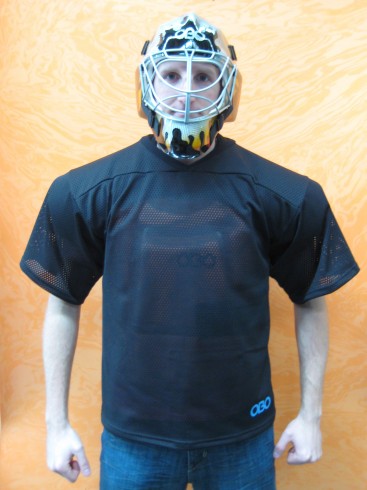
The smock is made from the mesh and comes in any colour as long as its black. Based on demand and your feedback we can add more colours and look at some modification so please drop us a comment on your thoughts…
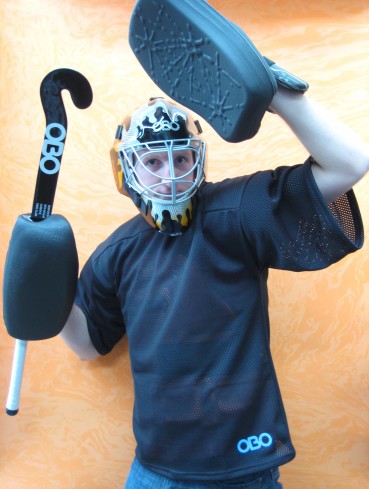
Before you ask i’m wearing a CLOUD body armour, ROBO hi-control hand protectors, Skinny thing stick and a ROBO FG helmet.
This product should be available from December 09.